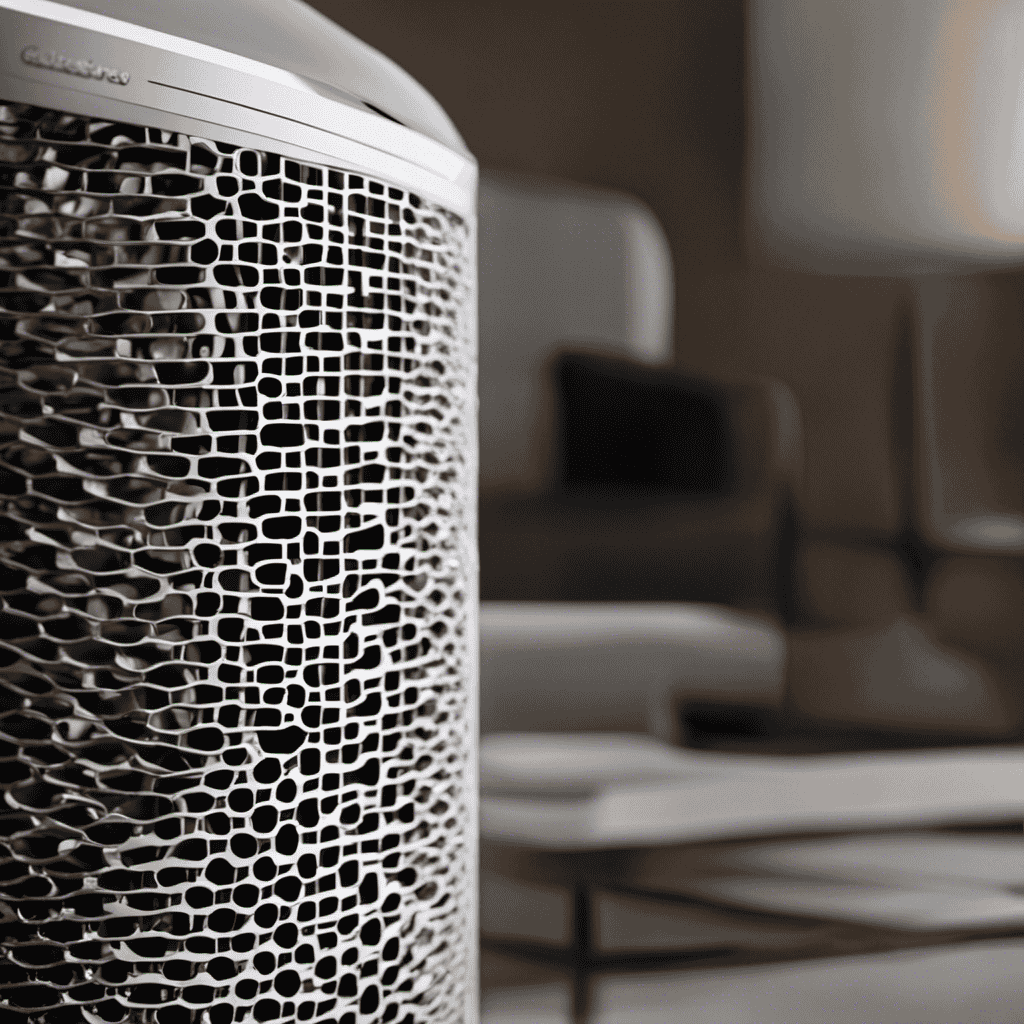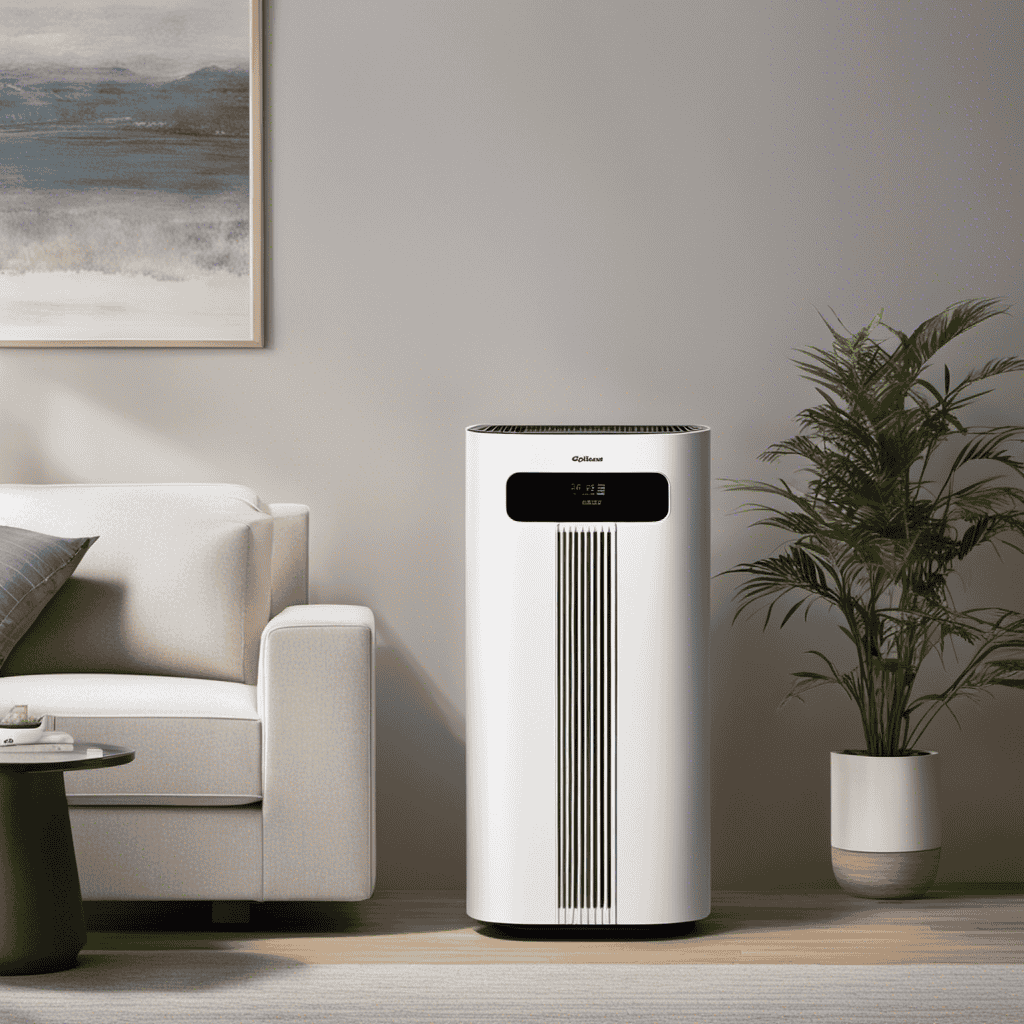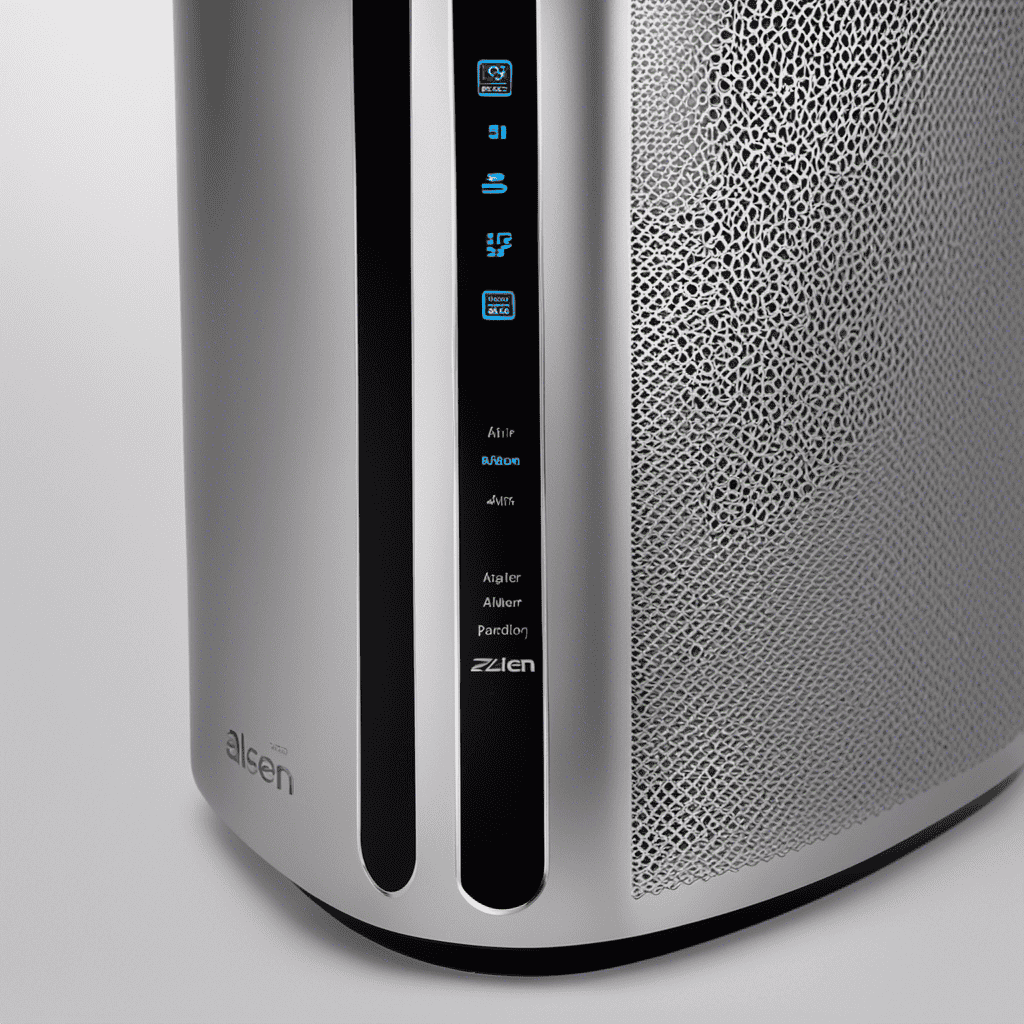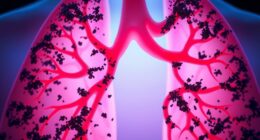As a fan of air purifiers, I have learned that keeping a HEPA filter well-maintained is essential for ensuring clean and healthy indoor air.
But how often should you replace this vital component?
In this article, we’ll delve into the factors affecting the lifespan of a HEPA filter, the importance of regular replacements, and the signs that indicate it’s time for a new one.
So sit back, relax, and let’s uncover the secrets to maintaining your air purifier’s efficiency.
Key Takeaways
- The lifespan of a HEPA filter in an air purifier can be affected by various factors such as the quality of the filter, air quality in the area, frequency of use, and adherence to manufacturer’s instructions.
- Regular replacement of the HEPA filter is important as it ensures optimal air purifier performance by capturing up to 99.97% of airborne particles. Over time, accumulated particles in the filter can reduce its efficiency, making replacement every 6-12 months recommended.
- HEPA filter degradation occurs as particles accumulate in the filter, leading to a loss of filtration capacity and decreased airflow. This can significantly impact the efficiency and performance of the air purifier, emphasizing the need for regular maintenance.
- Signs indicating the need for HEPA filter replacement include decreased air quality, increased allergy symptoms, and the presence of a filter replacement indicator on the air purifier. Timely replacement not only improves air quality but also prolongs the lifespan of the filter.
Factors Affecting the Lifespan of a HEPA Filter
You should consider several factors that affect the lifespan of your HEPA filter.
Proper HEPA filter maintenance is crucial to ensure its optimal performance and longevity.
One of the key factors impacting filter efficiency is the air quality in your environment. If you live in an area with high levels of pollution, dust, or allergens, your filter may get clogged more quickly and require more frequent replacements.
Another factor to consider is the usage of your air purifier. If you use it constantly or in a heavily trafficked area, the filter will accumulate more particles and contaminants, reducing its lifespan.
Additionally, the quality of the filter itself plays a significant role. Cheap or low-quality filters may not last as long as higher quality ones.
Regularly cleaning and replacing your HEPA filter when necessary will ensure that your air purifier continues to provide clean and healthy air.
The Importance of Regular Filter Replacements
Regularly replacing the HEPA filter in an air purifier is crucial. A clean HEPA filter ensures that the air purifier functions at its optimum level, providing you with clean and healthy air.
HEPA filters are designed to capture up to 99.97% of airborne particles, including dust, pollen, pet dander, and even bacteria and viruses. Over time, these particles accumulate in the filter, reducing its efficiency and airflow.
To maintain the effectiveness of your air purifier, it is recommended to replace the HEPA filter every 6-12 months, depending on usage and air quality. Some recommended filter brands include Honeywell, Blueair, and Coway.
Understanding HEPA Filter Degradation
Understanding how HEPA filters degrade over time is essential for maintaining the efficiency of your air purifier. Here are three important factors to consider:
-
Accumulation of Particles: HEPA filters work by trapping microscopic particles in the air. Over time, the filter becomes clogged with dust, pollen, pet dander, and other pollutants. As a result, the air quality degradation is noticeable, and the filter’s efficiency decreases.
-
Loss of Filtration Capacity: As the filter becomes saturated with particles, its ability to capture new contaminants diminishes. This can lead to decreased filter efficiency, allowing more pollutants to circulate in the air, affecting air quality.
-
Decreased Airflow: A clogged HEPA filter can restrict the airflow in your air purifier, causing the unit to work harder to maintain the desired air quality. This puts extra strain on the motor and may lead to decreased performance and higher energy consumption.
Understanding these aspects of HEPA filter degradation is crucial for ensuring that your air purifier functions optimally. Now, let’s explore the signs that indicate it’s time to replace your HEPA filter.
Signs That It’s Time to Replace Your HEPA Filter
As an air purification expert, I’ve noticed that many people are unaware of the importance of regularly replacing their HEPA filters. In this discussion, we will explore the key indicators that signal it’s time for a filter replacement.
Not only can a degraded filter result in decreased air quality, but it can also lead to increased allergy symptoms. This makes it crucial to stay on top of filter maintenance.
Filter Replacement Indicators
Have you checked if your air purifier has a filter replacement indicator? It’s a feature that can greatly benefit you when it comes to maintaining clean and healthy air in your home.
Here are three reasons why having a filter replacement indicator is essential:
-
Timely replacement: With a filter replacement indicator, you’ll never have to guess when it’s time to change your air purifier’s filter. It will notify you when the filter needs to be replaced, ensuring that you always have optimal air purification.
-
Prolonged filter lifespan: By replacing the filter at the right time, you can extend its lifespan. The indicator prevents you from replacing the filter too early or too late, saving you money in the long run.
-
Improved air quality: Regularly changing the filter as indicated by the indicator guarantees that your air purifier is working efficiently. This means you’ll continuously enjoy clean air, free from pollutants and allergens.
Having a filter replacement indicator is crucial for maintaining a healthy and clean indoor environment. But what happens when the air quality starts to decline? Let’s explore that in the next section.
Decreased Air Quality
When your indoor air quality decreases, it’s important to identify the potential causes and take necessary actions to address them.
Poor air quality can have a significant impact on your overall well-being, leading to increased respiratory issues and other health problems.
There are several factors that can contribute to decreased air quality, such as inadequate ventilation, the presence of indoor pollutants, and a build-up of allergens and dust.
Inadequate ventilation can trap pollutants inside your home, while indoor pollutants, such as volatile organic compounds (VOCs) and pet dander, can worsen air quality.
Additionally, a build-up of allergens and dust can trigger allergies and respiratory problems.
To improve air quality, it is important to address these potential causes by ensuring proper ventilation, regularly cleaning and maintaining your living space, and using air purifiers or filters to remove contaminants from the air.
Increased Allergy Symptoms
During my research on the impact of decreased air quality, I discovered that one of the consequences is an increase in allergy symptoms. This is particularly evident during seasonal changes when there is an influx of allergens in the air.
To help you understand the severity of this issue, let me provide you with three important points:
-
Increased air pollution: Seasonal changes can lead to an increase in air pollution due to factors such as pollen, dust, and mold spores. These pollutants can trigger allergic reactions and worsen existing symptoms.
-
Impact of seasonal changes: When seasons change, different plants release their pollen, resulting in a higher concentration of allergens in the air. This can cause a spike in allergy symptoms, including sneezing, itchy eyes, and congestion.
-
Need for air purification: Given the increased air pollution during seasonal changes, it becomes crucial to have an efficient air purifier with a HEPA filter. Regularly replacing the HEPA filter ensures that allergens are effectively captured, reducing allergy symptoms and improving indoor air quality.
Understanding the link between increased air pollution and the impact of seasonal changes on allergy symptoms emphasizes the importance of maintaining a clean and efficient air purifier.
How Long Does a HEPA Filter Typically Last
You should regularly replace the HEPA filter in your air purifier to ensure optimal performance. The lifespan of a HEPA filter can vary depending on several factors, such as the quality of the filter, the air quality in your area, and the frequency of use.
On average, a HEPA filter can last anywhere from six months to two years. However, it is important to note that these numbers are just estimates, and the actual lifespan may differ. To determine when to replace your HEPA filter, it is recommended to refer to the manufacturer’s instructions or guidelines.
Additionally, some air purifiers come with filter replacement indicators that can help you track the usage and indicate when it’s time for a new filter. Regularly replacing your HEPA filter will ensure that your air purifier continues to effectively remove allergens, pollutants, and other airborne particles from your indoor air.
Frequency of Filter Replacements for Different Air Purifier Brands
To ensure optimal performance, it’s important to check the manufacturer’s guidelines for different air purifier brands regarding how frequently you should replace the filters.
Here are three important factors that can affect the efficiency of air purifier filters:
-
Filter Type: Different air purifier brands use various types of filters, such as HEPA (High-Efficiency Particulate Air) filters, activated carbon filters, or pre-filters. Each filter type has its own lifespan and efficiency level, so it’s crucial to follow the manufacturer’s recommendations for replacement.
-
Air Pollution Levels: The level of air pollution in your environment greatly impacts the performance of the filters. High levels of pollutants, such as dust, pollen, pet dander, or smoke, can quickly clog the filters and reduce their efficiency. Regularly replacing the filters is necessary in areas with high pollution levels.
-
Usage and Maintenance: The frequency of filter replacement also depends on how often the air purifier is used and how well it is maintained. If the purifier runs continuously or in heavily polluted environments, the filters may need to be replaced more frequently.
Considering these factors and the impact of air pollution on filter performance, it’s crucial to adhere to the manufacturer’s guidelines for replacement to maintain optimal efficiency and ensure clean air in your surroundings.
The Role of Air Quality in Determining Filter Replacement Frequency
By considering the level of air pollution in your environment, you can determine how frequently the filters in your air purifier need to be replaced.
Air pollution can have detrimental effects on our health, so it is crucial to maintain the efficiency of air purifier filters.
The filter efficiency measurement is a key factor in determining when to replace the filters. The efficiency of a filter is usually represented by its Minimum Efficiency Reporting Value (MERV) rating. The higher the MERV rating, the more efficient the filter is in capturing small particles. However, as the filter captures more particles, it becomes clogged and less effective over time.
Regularly monitoring the air pollution level and the filter efficiency measurement can help you determine when it is time to replace the filters in your air purifier and ensure that you are breathing clean and healthy air.
How to Check if Your HEPA Filter Needs to Be Replaced
To determine if your HEPA filter needs replacement, check for any signs of discoloration or dirt accumulation on the filter surface. Here are three key indicators to look out for:
-
Discoloration: If you notice any dark or brownish spots on your HEPA filter, it is likely a sign of dirt buildup. This can restrict airflow and reduce the filter’s effectiveness in capturing airborne particles.
-
Reduced Airflow: A dirty HEPA filter can cause a decrease in the airflow emitted from your air purifier. If you notice a significant decrease in the air circulation, it may be time to replace the filter.
-
Odor or Allergies: If you start experiencing unpleasant odors or allergy symptoms even with the air purifier running, it could be a sign that your HEPA filter is no longer effectively removing pollutants from the air.
Regular maintenance and cleaning can help prolong the lifespan of your HEPA filter. Vacuuming the surface gently or rinsing it with water can help remove dirt and debris, but eventually, replacement will be necessary to maintain optimal performance.
Tips for Extending the Lifespan of Your HEPA Filter
If you want to maximize the lifespan of your HEPA filter, remember to regularly clean and maintain it. Proper maintenance is crucial for extending the filter’s lifespan and maximizing its performance.
First, make sure to vacuum the outer surface of the filter regularly to remove any large particles or debris. This will prevent the filter from becoming clogged and reduce strain on the motor.
Additionally, consider using a soft brush or compressed air to clean the filter’s pleats and ridges. This will help remove any trapped dust or allergens, allowing for better airflow and improved filtration efficiency.
Lastly, be sure to replace the filter according to the manufacturer’s recommendations to ensure optimal performance.
The Impact of Indoor and Outdoor Pollution on Filter Longevity
In my previous discussion about extending the lifespan of HEPA filters, I mentioned some tips to keep them running efficiently for longer. However, it’s important to understand the impact of both indoor and outdoor pollution on the overall efficiency of these filters. Here are three key points to consider:
-
Effect of air pollution on filter efficiency: HEPA filters are designed to capture small particles, but prolonged exposure to high levels of air pollution can clog the filter faster. Pollutants like dust, pollen, and smoke can significantly reduce its effectiveness over time.
-
Impact of outdoor pollution on indoor air quality: Outdoor air pollution can easily penetrate indoor spaces, putting additional strain on HEPA filters. If you live in an area with high pollution levels, your filter may need to be replaced more frequently to maintain good indoor air quality.
-
Regular monitoring and maintenance: To ensure optimal filter efficiency, it’s crucial to regularly monitor the air quality and check the filter for any signs of clogging. This can help you determine when it’s time to replace the filter and maintain a healthy indoor environment.
Recommended Maintenance Schedule for HEPA Filters
Make sure you regularly clean and vacuum the area around your HEPA filter to prevent dust and debris buildup. This is crucial for maintaining the efficiency and longevity of your air purifier. In addition to regular cleaning, it is important to understand the recommended maintenance schedule for HEPA filters. The lifespan of a HEPA filter can vary depending on usage and environmental factors. To help you gauge when to replace your filter, refer to the table below:
| Filter Type | Recommended Lifespan |
|---|---|
| Standard | 6-12 months |
| Enhanced | 9-18 months |
| Premium | 12-24 months |
It is important to note that these are general guidelines, and actual filter lifespan may vary. Factors such as pollutant levels, air quality, and usage patterns can all impact the filter’s lifespan. Keeping track of the filter’s usage and regularly checking its condition will help you determine when it needs replacement. By following a regular maintenance schedule, you can ensure that your air purifier continues to provide clean and healthy air for you and your family.
With regular maintenance and timely filter replacements, you can optimize the performance of your air purifier and ensure its longevity. However, it’s important to consider the cost implications of replacing HEPA filters. In the next section, we will explore the various factors that influence the cost of replacing HEPA filters and provide some tips to minimize expenses while maintaining the effectiveness of your air purifier.
The Cost Implications of Replacing HEPA Filters
To minimize expenses while maintaining the effectiveness of your device, consider factors that influence the cost of replacing HEPA filters. Here are three key aspects to keep in mind:
-
Filter Lifespan: Understanding the lifespan of your HEPA filter is crucial. Different models have varying lifespans, typically ranging from 6 months to 2 years. Regularly checking the manufacturer’s recommendations will help you plan for replacements and avoid premature filter changes.
-
Filter Type: The cost of replacing HEPA filters can vary depending on the specific type required for your air purifier. Some filters, such as carbon-activated or washable filters, may be more cost-effective in the long run compared to standard HEPA filters.
-
DIY Filter Cleaning: Consider the option of cleaning and reusing your HEPA filter. This can be a cost-saving alternative, especially if your filter is washable. However, it is important to follow proper cleaning instructions to maintain the filter’s efficiency.
Differentiating Between HEPA Filter Cleaning and Replacement
When deciding between HEPA filter cleaning and replacement, you should consider the effectiveness and cost-effectiveness of each option.
HEPA filter maintenance is crucial to ensure the optimal performance of your air purifier. Cleaning the filter involves removing the accumulated dirt and debris from the surface. This can be done by gently vacuuming or washing the filter with water and mild detergent.
However, it is important to note that cleaning may not completely restore the filter’s efficiency, especially if it is heavily soiled or damaged. In such cases, replacement is recommended.
While cleaning can be a more cost-effective option in the short term, regular replacement ensures that your air purifier continues to provide clean and healthy air. Remember to follow the manufacturer’s guidelines for proper maintenance and replacement intervals to maximize the lifespan of your HEPA filter.
The Dangers of Using a Clogged or Expired HEPA Filter
As an air quality expert, I can’t stress enough the importance of regularly replacing your HEPA filter in your air purifier.
Using a clogged or expired filter can pose serious health risks. A clogged filter restricts airflow, reducing the purifier’s effectiveness and allowing harmful particles to linger in the air.
This can potentially lead to respiratory issues and allergies.
Health Risks of Clogged Filter
The health risks of a clogged filter can include decreased air quality and increased exposure to pollutants. Here are three key reasons why maintaining a clean filter is essential for your respiratory health:
-
Reduced air circulation: A clogged filter restricts the flow of air, preventing it from effectively circulating throughout the room. This can lead to stagnant air and a buildup of harmful particles, such as dust, pet dander, and allergens.
-
Increased allergen exposure: Without a properly functioning filter, allergens and other airborne pollutants can accumulate in your living space. This can trigger allergies, asthma attacks, and other respiratory issues, especially for individuals with pre-existing conditions.
-
Decreased filter efficiency: Over time, a clogged filter loses its ability to effectively capture and trap pollutants. This means that even if you have an air purifier, it won’t be able to efficiently clean the air. Regularly replacing or cleaning your filter is crucial to maintain optimal air quality and protect your respiratory health.
To ensure the longevity and effectiveness of your filter, follow these filter maintenance tips:
- Check the manufacturer’s recommendations for filter replacement frequency.
- Vacuum or clean the filter regularly, depending on the type.
- Keep an eye out for signs of a clogged filter, such as reduced airflow or a musty smell.
Importance of Filter Replacement
As I mentioned earlier, clogged filters can pose serious health risks. That’s why it’s crucial to understand the importance of filter replacement in air purifiers. Regularly replacing the filter ensures optimal performance and clean air quality in your indoor environment.
To better understand filter efficiency and the benefits of clean air, let’s take a look at the following table:
| Filter Type | Efficiency Rating (%) | Benefits |
|---|---|---|
| HEPA | 99.97 | – Removes allergens, dust, and pet dander from the air. |
| Carbon | Varies | – Eliminates odors and harmful gases. |
| Pre-filter | Varies | – Extends the lifespan of the main filter. |
| UV-C | Varies | – Kills bacteria and viruses. |
Is Changing the Air Purifier Filter the Same as Replacing the Hepa Filter?
Changing the air purifier filter is not the same as replacing the HEPA filter. The air purifier filter change frequency depends on the type of filter used, while the HEPA filter specifically targets small particles and allergens. It’s important to follow the manufacturer’s guidelines for both to maintain air quality.
Other Factors to Consider When Determining Filter Replacement Frequency
When determining the frequency for replacing the HEPA filter in an air purifier, there are other factors to consider. Here are three important factors to keep in mind:
-
Air Quality: The air quality of your environment plays a significant role in filter replacement frequency. If you live in a highly polluted area or have pets or smokers at home, the filter may need to be replaced more frequently.
-
Usage: The frequency of filter replacement also depends on how often you use the air purifier. If it runs continuously or for extended periods, the filter will accumulate more pollutants and require more frequent replacements.
-
Filter Quality: Different filter brands have varying lifespans. It is important to choose a recommended filter brand that offers high-quality filters. While they may cost more initially, they will last longer and provide better air purification, ultimately saving you money on filter replacement costs in the long run.
Considering these factors will help you determine the optimal frequency for replacing the HEPA filter in your air purifier.
Frequently Asked Questions
Can a HEPA Filter Be Cleaned and Reused Instead of Being Replaced?
Yes, a HEPA filter can be cleaned and reused, but it is recommended to replace it instead. Cleaning methods vary, but the benefits of using a new HEPA filter include improved air quality and better filtration efficiency.
Is It Possible to Extend the Lifespan of a HEPA Filter Without Compromising Its Effectiveness?
To maintain a HEPA filter’s effectiveness and extend its lifespan, it’s important to follow manufacturer guidelines for regular replacement. Common misconceptions about HEPA filter lifespan include trying to clean or reuse them, which can compromise their effectiveness.
Are There Any Health Risks Associated With Using a Clogged or Expired HEPA Filter?
Using a clogged or expired HEPA filter in an air purifier can pose health risks. Regular filter replacement is important to maintain effectiveness and prevent the buildup of pollutants, ensuring clean and healthy air.
Besides Air Quality, What Other Factors Should Be Considered When Determining the Frequency of HEPA Filter Replacements?
When determining the frequency of HEPA filter replacements, cost considerations and environmental impact should also be taken into account. It’s important to balance clean air with the financial and ecological consequences of frequent filter changes.
How Much Does It Typically Cost to Replace a HEPA Filter in an Air Purifier?
Replacing a HEPA filter in an air purifier typically costs around $20 to $50, depending on the brand and model. However, there are alternative options available, such as washable filters, which can save on long-term costs.
Conclusion
In conclusion, it’s crucial to regularly replace the HEPA filter in your air purifier. This will help maintain its effectiveness in removing harmful particles from the air. Studies have shown that a clogged or expired HEPA filter can reduce its efficiency by up to 50%. This statistic is alarming because it highlights the potential health risks associated with using a compromised filter.
By staying proactive and replacing your HEPA filter as recommended by the manufacturer, you can ensure that your air purifier continues to provide clean and healthy air for you and your family.










